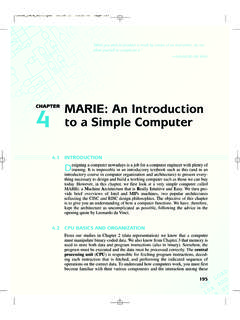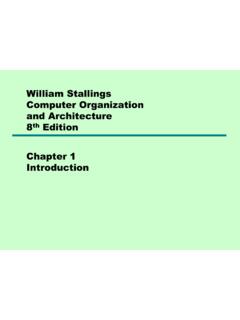Transcription of arXiv:1606.02147v1 [cs.CV] 7 Jun 2016
1 ENet: A Deep Neural network architecture forReal-Time Semantic SegmentationAdam PaszkeFaculty of Mathematics, Informatics and MechanicsUniversity of Warsaw, Chaurasia, Sangpil Kim, Eugenio CulurcielloElectrical and computer EngineeringPurdue University, USAaabhish, sangpilkim, ability to perform pixel-wise semantic segmentation in real-time is ofparamount importance in mobile applications. Recent deep neural networks aimedat this task have the disadvantage of requiring a large number of floating point oper-ations and have long run-times that hinder their usability.
2 In this paper, we proposea novel deep neural network architecture named ENet (efficient neural network ),created specifically for tasks requiring low latency operation. ENet is up to 18 faster, requires 75 less FLOPs, has 79 less parameters, and provides similar orbetter accuracy to existing models. We have tested it on CamVid, Cityscapes andSUN datasets and report on comparisons with existing state-of-the-art methods,and the trade-offs between accuracy and processing time of a network . We presentperformance measurements of the proposed architecture on embedded systems andsuggest possible software improvements that could make ENet even IntroductionRecent interest in augmented reality wearables, home-automation devices, and self-driving vehicleshas created a strong need for semantic-segmentation (or visual scene-understanding) algorithmsthat can operate in real-time on low-power mobile devices.
3 These algorithms label each and everypixel in the image with one of the object classes. In recent years, the availability of larger datasetsand computationally-powerful machines have helped deep convolutional neural networks (CNNs)[1,2,3,4] surpass the performance of many conventional computer vision algorithms [5,6,7]. Eventhough CNNs are increasingly successful at classification and categorization tasks, they provide coarsespatial results when applied to pixel-wise labeling of images. Therefore, they are often cascaded withother algorithms to refine the results, such as color based segmentation [8] or conditional randomfields [9], to name a order to both spatially classify and finely segment images, several neural network architectureshave been proposed, such as SegNet [10,11] or fully convolutional networks [12].
4 All these worksare based on a VGG16 [13] architecture , which is a very large model designed for multi-classclassification. These references propose networks with huge numbers of parameters, and longinference times. In these conditions, they become unusable for many mobile or battery-poweredapplications, which require processing images at rates higher than 10 this paper, we propose a new neural network architecture optimized for fast inference and highaccuracy. Examples of images segmented using ENet are shown in Figure 1. In our work, we [ ] 7 Jun 2016 InputimageENetoutputFigure 1: ENet predictions on different datasets (left to right Cityscapes, CamVid, and SUN).
5 Not to use any post-processing steps, which can of course be combined with our method, but wouldworsen the performance of an end-to-end CNN Section 3 we propose a fast and compact encoder-decoder architecture named ENet. It has beendesigned according to rules and ideas that have appeared in the literature recently, all of which wediscuss in Section 4. Proposed network has been evaluated on Cityscapes [14] and CamVid [15]for driving scenario, whereas SUN dataset [16] has been used for testing our network in an indoorsituation. We benchmark it on NVIDIA Jetson TX1 Embedded Systems Module as well as on anNVIDIA Titan X GPU.
6 The results can be found in Section Related workSemantic segmentation is important in understanding the content of images and finding target technique is of utmost importance in applications such as driving aids and augmented , real-time operation is a must for them, and therefore, designing CNNscarefullyis computer vision applications extensively use deep neural networks, which are nowone of the most widely used techniques for many different tasks, including semantic work presents a new neural network architecture , and therefore we aim to compare to otherliterature that performs the large majority of inference in the same scene-parsing CNNs use two separate neural network architectures combined together:an encoder and a decoder.
7 Inspired by probabilistic auto-encoders [17,18], encoder-decoder networkarchitecture has been introduced in SegNet-basic [10], and further improved in SegNet [11]. Theencoder is a vanilla CNN (such as VGG16 [13]) which is trained to classify the input, while thedecoder is used to upsample the output of the encoder [12,19,20,21,22]. However, these networksare slow during inference due to their large architectures and numerous parameters. Unlike infully convolutional networks (FCN) [12], fully connected layers of VGG16 were discarded in thelatest incarnation of SegNet, in order to reduce the number of floating point operations and memoryfootprint, making it the smallest of these networks.
8 Still, none of them can operate in existing architectures use simpler classifiers and then cascade them with Conditional RandomField (CRF) as a post-processing step [9,23]. As shown in [11], these techniques use onerouspost-processing steps and often fail to label the classes that occupy fewer number of pixels in a can be also combined with recurrent neural networks [20] to improve accuracy, but then theysuffer from speed degradation. Also, one has to keep in mind that RNN, used as a post-processingstep, can be used in conjunction with any other technique, including the one presented in this network architectureThe architecture of our network is presented in Table 1.
9 It is divided into several stages, as highlightedby horizontal lines in the table and the first digit after each block name. Output sizes are reported foran example input image resolution of512 512. We adopt a view of ResNets [24] that describesthem as having a single main branch and extensions with convolutional filters that separate from it,2 Input3x3, stride 2 MaxPoolingConcat(a)PReLU+Regularizer1x1c onvMaxPoolingPadding1x1 PReLUPReLU(b)Figure 2: (a) ENet initial block. MaxPooling is performed with non-overlapping2 2windows,and the convolution has 13 filters, which sums up to 16 feature maps after concatenation.
10 Thisis heavily inspired by [28]. (b) ENet bottleneck either a regular, dilated, or fullconvolution (also known as deconvolution) with3 3filters, or a5 5convolution decomposedinto two asymmetric then merge back with an element-wise addition, as shown in Figure 2b. Each block consistsof three convolutional layers: a1 1projection that reduces the dimensionality, a main convolu-tional layer (convin Figure 2b), and a1 1expansion. We place Batch Normalization [25] andPReLU [26] between all convolutions. Just as in the original paper, we refer to these as bottleneckmodules.




![arXiv:0706.3639v1 [cs.AI] 25 Jun 2007](/cache/preview/4/1/3/9/3/1/4/b/thumb-4139314b93ef86b7b4c2d05ebcc88e46.jpg)

![arXiv:1301.3781v3 [cs.CL] 7 Sep 2013](/cache/preview/4/d/5/0/4/3/4/0/thumb-4d504340120163c0bdf3f4678d8d217f.jpg)
![@google.com arXiv:1609.03499v2 [cs.SD] 19 Sep 2016](/cache/preview/c/3/4/9/4/6/9/b/thumb-c349469b499107d21e221f2ac908f8b2.jpg)





![arXiv:1512.00567v3 [cs.CV] 11 Dec 2015](/cache/preview/e/9/b/2/7/3/a/d/thumb-e9b273ad52b2edb6f94a58f5caa30476.jpg)




